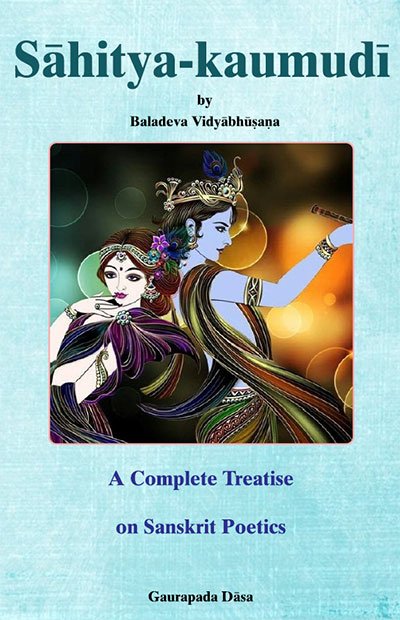Sahitya-kaumudi by Baladeva Vidyabhushana
by Gaurapada Dāsa | 2015 | 234,703 words
Baladeva Vidyabhusana’s Sahitya-kaumudi covers all aspects of poetical theory except the topic of dramaturgy. All the definitions of poetical concepts are taken from Mammata’s Kavya-prakasha, the most authoritative work on Sanskrit poetical rhetoric. Baladeva Vidyabhushana added the eleventh chapter, where he expounds additional ornaments from Visv...
Text 10.68
यथा वा,
कामं सर्वाभीष्ट-कन्दं मुकुन्दं या निर्बन्धात् प्राहिणोद् इन्धनाय ।
आचार्यानी सा करोति स्म पण्यं पिण्याकार्थं हन्त चिन्तामणीन्द्रम् ॥
yathā vā,
kāmaṃ sarvābhīṣṭa-kandaṃ mukundaṃ yā nirbandhāt prāhiṇod indhanāya |
ācāryānī sā karoti sma paṇyaṃ piṇyākārthaṃ hanta cintāmaṇīndram ||
kāmam—at will; sarva-abhiṣṭa—of all that is desired; kandam—the root; mukundam—Mukunda; yā—who; nirbandhāt—perseveringly; prahiṇot—she sent; indhanāya—for firewood; ācāryānī—the guru’s wife[1]; sā—she; karoti sma—made; panyam—a purchase; pinyaka—the residue of sesame seeds crushed for oil; artham—for; hanta—alas; cintamaṇi—of cintamaṇi jewels; indram—the king.
This is another example. [Gārgī speaks:]
Sāndīpani Muni’s wife’s perseveringly sending Mukunda, who fulfills all desires at will, to fetch firewood is her purchasing residually crushed sesame at the cost of the best cintāmaṇi jewel. (Lalita-mādhava)
atra cintāmaṇinā piṇyākaṃ krīṇatīva kṛṣṇenendhanam āharanty ācāryāṇīty upamāyāṃ paryavasitiḥ.
The verse culminates in this simile: Her acquiring firewood by means of Kṛṣṇa is like buying residual sesame with a cintāmaṇi.
Commentary:
In this regard, Paṇḍita-rāja Jagannātha propounds a variety of metaphor called vākyārtha-rūpaka (a metaphor between the meanings of sentences):
ātmano’sya tapo-dānair nirmilī-karaṇaṃ hi yat |
kṣālanaṃ bhāskarasyedaṃ sārasaiḥ salilotkaraiḥ ||“Purifying the soul by means of austerity and charity is the washing of the sun with heaps of water from a lake” (Rasa-gaṅgādhara, KM p. 238).
However, the verse can be classed as a nidarśanā. According to Nāgeśa Bhaṭṭa, in a metaphor the upamāna (standard of comparison) must not be far-fetched.[2]
This is Mammaṭa’s other example of nidarśanā,
udayati vitatordhva-raśmi-rajjāv ahima-rucau hima-dhāmni yāti cāstam |
vahati girir ayaṃ vilambi-ghaṇṭādvaya-parivārita-vāraṇendra-līlām ||“When the sun, with the ropes of its rays shooting upward, is rising and the moon is setting, this mountain (Raivataka) assumes the resplendence of a regal elephant who has a bell dangling on each side.” (Śiśupāla-vadha 4.20)
Mammaṭa elaborates:
atra katham anyasya līlām anyo vahatīti tat-sadṛśīm ity upamāyāṃ paryavasānam,
“In regard to this verse, how can one thing assume the very resplendence of another thing? Therefore the sense culminates in a simile: The mountain assumed a resplendence that was like the resplendence of the other things” (Kāvya-prakāśa verse 436 vṛtti).
In Daṇḍī’s methodology, however, such a wording literally expresses a simile.
This is his example of his variety of simile called adbhutā upamā (amazing simile):
yadi kiñcid bhavet padmaṃ subhru vibhrānta-locanam |
tat te mukha-śriyaṃ dhattām ity asāv adbhutopamā ||“Girl with beautiful brows, if there exists some lotus that catches the eye, it must have assumed the resplendence of your face” (Kāvyādarśa 2.24).
Footnotes and references:
[1]:
The letter n in the word ācāryānī is not cerebral, by the rule: ācāryād aṇatvaṃ ca (Vārttika 4.1.49).
[2]:
“tvat-pāda-nakha-ratnānāṃ yad alakta-mārjanam, idaṃ śrīkhaṇḍa-lepena pāṇḍurīkaraṇaṃ vidhoḥ” [Alaṅkāra-sarvasva] ity atrāpy eṣaiva. na cedaṃ vākyārtha-rūpakam, loka-prasiddhopamānatvopameyatvavayor abhedasyaiva rūpakatvāt. kiṃ ca tatra sādṛśyalakṣaṇā-mūlābheda-pratītiḥ, iha tu pratīyamānābhedānupapattyā tattva-kalpaneti bhedāt (Uddyota on Kāvya-prakāśa verse 435). Jagannātha finds fault with the verse (tvat-pāda-nakharatnānāṃ etc.) and calls it vākyārtha-rūpaka (Rasa-gaṅgādhara, KM pp. 342-343).
